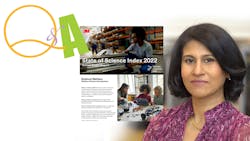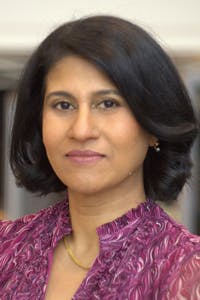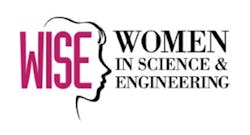Consider the facts: The importance of science in America has risen by double digits since its lowest point in 2019. Scientists and engineers are the most credible sources in the U.S.
These two data points were revealed in the 3M 2022 State of Science Index conducted by Ipsos. The study is designed to provide a finger on the pulse of the public image of science across the general populations of 17 countries. The independent research reveals trend lines over time, as to how much people trust, respect and value science and the role it plays in our lives.
“We want to understand the public perception of science,” said Jayshree Seth, 3M’s chief science advocate and a corporate scientist who works with engineers and scientists to break down complex problems and find solutions. “What does the world feel about science? How does the public see its relevance and how do they view its importance for our future? We have been conducting this global survey for five years now, because we think science matters and we think what people think about science matters.”
That makes a good rationale for its coverage in Power & Motion, too. In the following transcript of a recent screencast, Seth unpeels (no pun intended!) the highlights of this year’s survey.
Power & Motion: I read the press materials and the report, and I came away with the idea that there is an overwhelmingly positive appreciation for science among Millennials and Gen Z. Can you give us your high-level overview of this year’s outlook?
Jayshree Seth: I can share three highlights that jumped out at me. First, it’s really good to see trust in science is high in America and throughout the world. Second, the public is very aware of widespread misinformation on social media and traditional media, and they’re very concerned about it. And third, people agree we need more diversity in science and Americans acknowledge that we need to do more for achieving equity in scientific fields. And, as you mentioned, our data indeed shows that the younger generation thinks about science more, appreciates it more. That trust and that interest that the younger generations have, I think is a great sign.
P&M: I will go through all of those themes that you mentioned categorically, but I want to step back for a moment. Give me a little bit more of a snapshot of the survey methodology and the broad scope of the population that actually participates in the study.
JS: 3M’s State of Science Index is original, independent research and the 2022 survey was conducted from late September to mid-December in 17 countries. Those countries among nationally representative thousand general population adults, and based on their census demographics of that particular country. The countries were picked to represent developed and developing economies, and included countries have specific interest based on 3M presence there. The list of countries are Australia, Brazil, Canada Colombia, China, France, Germany, India, Italy, Japan, Mexico, Poland, Singapore, South Korea, UAE, UK and, of course, the U.S. The survey was actually conducted by a global research firm Ipsos and a combination of online and offline interviews was used.
P&M: Despite the overall positive tone, the survey shows that misinformation remains widespread and that’s the sentiment that we’ve seen throughout the media. What can you tell us about the impact of misinformation on scientific credibility?
JS: The survey found that the public certainly believes that misinformation has become a big problem. People do place trust in news stories about science, higher than other topics like sports and health and entertainment. But overall, complete trust is low, so we have to address the problem of misinformation, especially as it relates to science.
As a scientist, misinformation is really concerning because it can threaten scientific credibility.
And the science community is also very concerned and the research around this field is coalescing. But the people recognize that it can have serious consequences. And, it is consequences across the board—in health issues, in public health matters, in addressing climate change, etc. But it’s interesting that many Americans (82%) actually said they want to hear more from scientists directly. So that does provide a great opportunity for scientists to communicate more often, on news and on social media platforms in any kind of opportunity that they get to connect with the public.
P&M: I certainly agree with that. And that’s why I love this platform. It creates that direct interface with our audiences. The report also uncovers some interesting data about climate change concerns. Can you elaborate on those concerns, especially among young people and people of color about being displaced from where they live?
JS: Yes, certainly. Our survey found that nearly seven in 10 Americans are concerned that they or a loved one might one day be displaced from their homes due to extreme weather related to climate change. Globally, actually 80% feared this, while 70% of those surveyed believe extreme weather is the number one direct impact of climate change. For Americans, that number is not far off, at 66%. When you look at the people of color in America, concern around displacement increases significantly (Black Americans 79%; U.S. Hispanics 76%; compared to the 70% overall American).
But it’s interesting: Across all demographics, 84% of Americans are confident that science can help to minimize the effects of climate change. Globally, that number is even higher; I think it’s 88%. And people agree that we should follow the science to help make the world more sustainable. You can see how, living through the pandemic, that science was able to provide a solution and there’s no doubt that it will eventually vanquish this pandemic. It has also provided this relationship for people to understand that science can solve other challenges as well.
P&M: Another topic is on barriers to STEM education. I’m going to read the statistics and then I’d love for you to comment on what the gap and the impact of each of these findings means to the scientific community. The first one is, “While nearly all Americans believe it is important to increase DE&I (diversity, equity and inclusion) in STEM fields (87%), about two-thirds also agree that underrepresented minority groups do not receive equal access to STEM education (69%)”. My questions are: What does this gap in the numbers tell you about the current state, and what can we learn from what seems to be an opportunity to address disparity?
JS: You’re absolutely right. I think it’s great to see that more Americans agree it’s important to increase diversity in STEM fields. And we also are acknowledging that STEM equity needs significant work. What it means to me is that people seem to understand that a diverse workforce is a robust workforce, that increasing diversity will be correlated with increasing innovation, increasing diversity will also lead to a more positive perception of science when people see the makeup of society reflected in the scientific community.
But we may also need to make the barriers faced by underrepresented minorities more visible, because we need to break them down to facilitate the diversity we need, and foster the inclusion, and further the cause of equity in STEM fields. It is critical to ensuring a robust and diverse pipeline of STEM talent.
This requires in my mind actions from the entire stakeholder spectrum. It’s not just access; it is exposure and it is the encouragement of economics in some cases, it is the empowerment people feel, it is the engagement, and then, by achieving of equity. I actually call it the echo system. I’m proud of 3M’s effort along the spectrum to help the cause. We’re addressing this at every point in this entire system.
P&M: Here’s one more statistic: “Americans differ sharply in their acknowledgment of a racial/ethnic gap in the STEM workforce. While 56% of all Americans believe a racial/ethnic gap exists in the STEM workforce, responses diverge within demographics: 72% of Black Americans and 61% of U.S. Hispanics report seeing a gap versus only 49% of white Americans.” How do you interpret these results? If we were to cast a DE&I (diversity, equity and inclusion) lens over the data, would you say that there’s a possible blind-spot effect here?
JS: Well, we know that there’s a representation gap. It’s very evident. But many people may not be seeing it because the perception doesn’t match the reality. We need greater acknowledgement of these gaps, so we can work on closing them. If people aren’t even seeing it or acknowledging it as a gap, how are we going to close it?
I just have to look around, and I can see that it isn’t where it should be based on the demographics. It’s easier to perhaps see lack of representation when you are part of the group that is underrepresented. The bottom line is, we need all the diversity of thought and experiences we can get in order to creatively solve the problems we face. I mean, it will be 9 billion of us just in a few decades. We need to unlock the secrets to a sustainable future and we need to make sure people understand we can’t do that if we all think the same, look the same, feel the same—or be from the same background, same community or same college, for that matter. And that is one reason we need diversity; it’s a matter of survival.
So, we have a lot of room for improvement on that STEM equity front. It has a wide-ranging impact—it impacts talent pipelines of companies like 3M and other science-based companies that I’m sure you talk to. People are slowly beginning to appreciate and understand that environments that lack diversity can be closed communities, like ECHO chambers.
And we have to somehow break that down because the same voices will continue to reflect and reverberate. And the problems will be identified with a narrow point of view. We have clearly seen with the pandemic that there is an urgent need for a broader perspective and social context for science and building a more diverse science community in science as a more inclusive space because a narrow view makes science itself vulnerable. And we don’t want that.
So, we at 3M understand this, and are aligned with the sustainable development goals. We’re committed to inclusive innovation and we want to create a diverse science community and a more positive world with science. We invite people to join us.
P&M: Healthcare shows up as a key area where Americans are looking to science for solutions. What insights can audiences—such as those who are in the medical devices industry or media outlets such as Machine Design—glean from the data in the survey?
JS: With the pandemic, it’s very clear that the connection between health and science perhaps got stronger. It’s not surprising. Our interest in our own health is actually a great way to pull people into science. When it comes to the data from our State of Science Index, the top healthcare advancements people want science to prioritize are cures for chronic diseases and cancer treatments and, interestingly in our 2022 results, the third position people say science should prioritize, is addressing mental and emotional health issues, with even more urgency than vaccines for future pandemics.
We also see across the world access to quality healthcare is considered the number one priority for most countries. I think it’s 13 out of 16 countries that ranked “improving access to quality healthcare” as top action for their country to prioritize. During the pandemic people got a chance to see how this plays out and how there is a disproportionate impact.
In regards to collaboration between corporations and healthcare, that is also a priority. Among top actions people want corporations to prioritize, beyond your core business purposes, is work with the healthcare industry and other entities, so you can improve quality of care and address the root causes of health disparity with underserved and underrepresented communities.
Due to the pandemic—how it disproportionately impacted some communities, how the death and devastation occurred, how lives are ended and upended—that social context is top of mind for people. Science has been given a very human context and societal perspective because of the pandemic. And healthcare is truly personal.
P&M: What surprises you about the data? The surprising finding for me was that Americans are less enthusiastic about futuristic innovations, such as self-driving vehicles. That is surprising. It was also interesting to read that excitement over artificial intelligence (AI) is not as high in the U.S. as it is globally, and it declines among older generations and white people. Can you make sense of this for me?
JS: It’s always interesting to see the results and then try to rationalize, right? We have had all sorts of discussions. I’ll share with you one perspective. Americans have actually had significant exposure now with EVs and they know the benefits and the kinks. It’s possible that their view may be more pragmatic. Maybe we can dig into this in our future research and look more into it.
Again, as for AI, there is so much discussion in the U.S. about how bias creeps in because of lack of representation. And that perhaps makes people more wary. Maybe. I mean, the data is what it is. It’s the rationalization and the context we can put behind it. That’s one way to think about it.
One surprising insight to me was that more people don’t recognize the role bias and prejudice towards women and racial minorities plays as a barrier to pursuing a strong STEM education. Only a quarter of Americans believe bias is a barrier. And it’s interesting: Last year we asked those who encountered barriers that held them back from STEM what the barriers were;
50% of those in the U.S. said that they felt discouraged and it was because of their gender, race or ethnicity. That figure was much higher in the U.S. than the global average; it was 50% in the U.S. and 27% the global average.
Regardless, I think greater diversity in sciences will lead to greater impact. I’ll tell you the way I like to say it is: Our world requires innovation. Innovation needs science. Science demands diversity. And diversity warranty equity.
I’m a passionate advocate for breaking down these biases and barriers and boundaries to help women and girls and minorities not just enter, but excel and persist in the field. A big part of this is role models. One of the things 3M did last year was a premier docu-series called, “Not the Science Type.” It features four diverse women scientists. I’m honored to be one of the scientists featured in it. With this docu-series we just want to inform and influence and inspire by showing that we can all be the science type, regardless of gender and race and age and ethnicity.
P&M: Thank you for sharing that. Let’s end with your key takeaway of the survey.
JS: The pandemic has really given science a lifeline of support. It was an interesting time. The entire world was facing the same existential crisis and confronting the same fears, and most of us waited for our gift of science in the vaccine. Science, which was seemingly invisible, underappreciated and taken for granted, was suddenly thrust in the public discourse. Scientists were centerstage. So, no surprise, it became the time to stem skepticism.
Since the pandemic trust remains high. People associate science with hope for the future, hope for the planet and for the next generation. STEM and the younger generations have a deeper connection with science—and that gives me hope.
This article appeared in Machine Design.
Editor’s Note: Power & Motion's Women in Science and Engineering (WISE) hub compiles our coverage of gender representation issues affecting the engineering field, in addition to contributions from equity seeking groups and subject matter experts within various subdisciplines.
About the Author
Rehana Begg
Senior Editor, Machine Design and Hydraulics & Pneumatics

Leaders relevant to this article:


